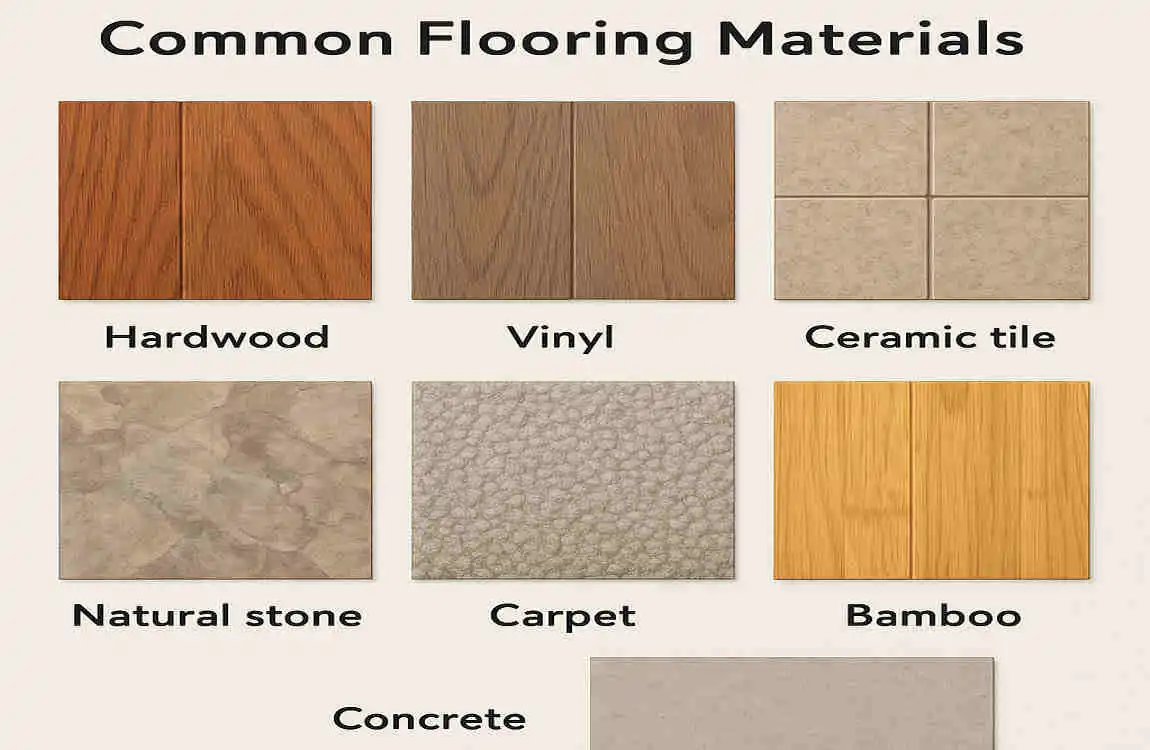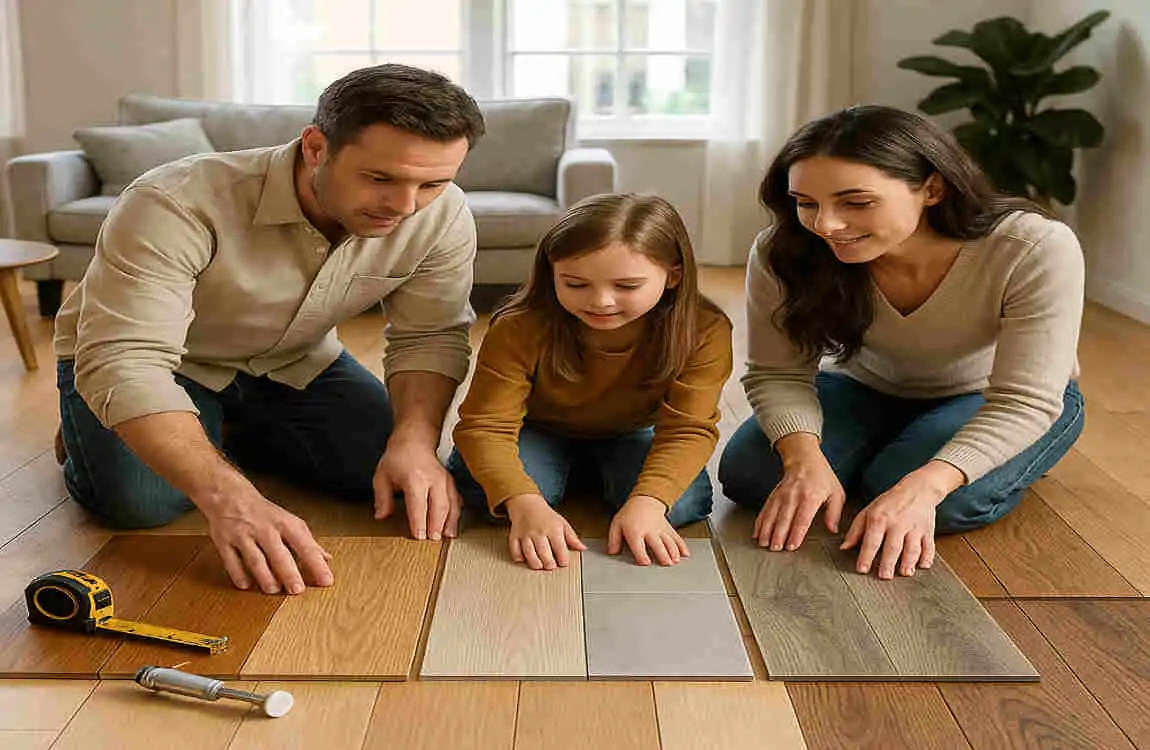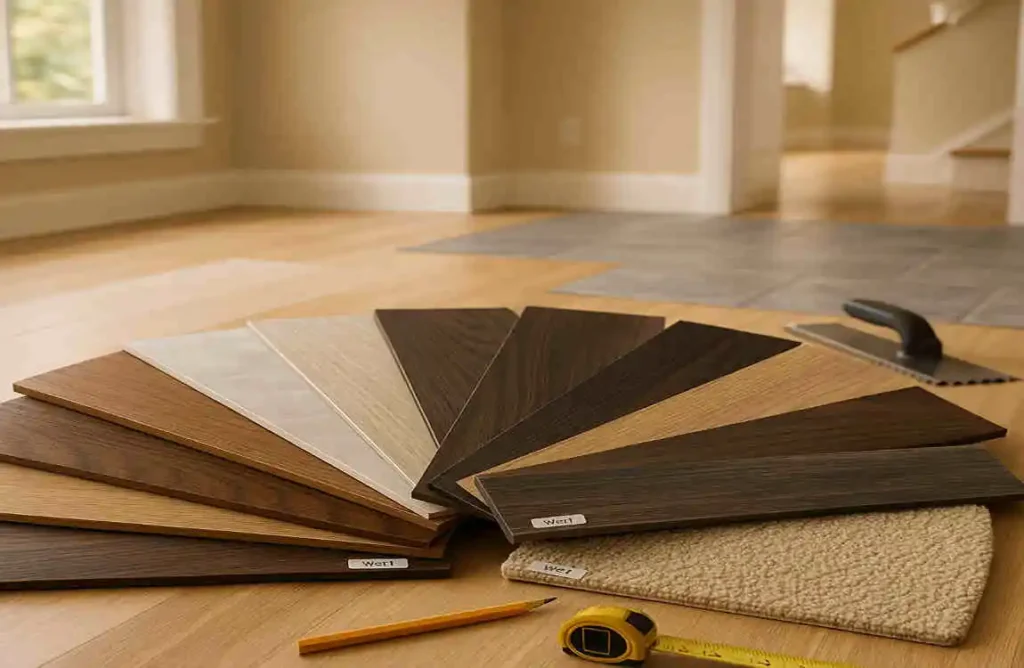Flooring is one of the most essential elements in home design. It’s the foundation of your living space, setting the tone for the rest of your decor while also playing a vital role in your home’s functionality. Whether you’re building, renovating, or simply upgrading your interior, the choice of flooring material can dramatically impact the look, feel, and even the value of your property.
What Is Flooring Material?

Flooring material refers to the surface layer of a floor that you walk on—it’s the finish that covers the structural foundation of your home. These materials come in a wide variety of types, textures, and finishes, each designed to serve specific purposes based on factors like durability, style, and practicality.
Types of Flooring Materials: Natural vs. Synthetic
Flooring materials can be broadly divided into two categories:
- Natural materials: These include hardwood, natural stone, bamboo, and cork. They are derived from organic sources and are often prized for their beauty, durability, and eco-friendliness.
- Synthetic materials: Vinyl, laminate, and engineered wood fall into this category. These are artificial options designed to mimic natural materials while offering additional benefits, such as affordability and water resistance.
Why Does Choosing the Right Flooring Material Matter?
The flooring material you choose will have a lasting impact on your home’s aesthetics, comfort, and functionality. It affects everything from the style of your space to how easy it is to clean and maintain. The right flooring also ensures durability, especially in high-traffic areas like hallways and kitchens, and can even influence your home’s resale value.
Common Types of Flooring Materials
Let’s explore some of the most popular flooring materials available today and their unique features.
Hardwood Flooring
Hardwood is one of the most sought-after flooring materials, thanks to its timeless beauty and durability.
- Key Features: Hardwood floors are made from natural wood, offering a warm and elegant appearance. They come in various wood species, such as oak, maple, and walnut, each with its own grain pattern and color.
- Durability: Properly maintained hardwood can last for decades. However, it’s vulnerable to scratches and moisture, so regular sealing and care are essential.
- Maintenance: Hardwood requires occasional refinishing to maintain its shine and protect against wear.
Laminate Flooring
Laminate flooring is a budget-friendly alternative to hardwood that mimics its appearance.
- How It’s Made: Laminate consists of a photographic layer that replicates the look of wood or stone, topped with a protective coating.
- Pros: Affordable, scratch-resistant, and relatively easy to install.
- Cons: It isn’t as durable as hardwood and can warp in high-moisture areas.
Vinyl Flooring
Vinyl flooring is a versatile and moisture-resistant option that’s perfect for busy households.
- Types: Vinyl comes in sheets, planks, and tiles, offering a range of design options.
- Benefits: It’s waterproof, affordable, and easy to maintain. Vinyl plank flooring, in particular, is popular for its ability to mimic the look of wood or stone.
- Where to Use: Ideal for kitchens, bathrooms, and basements.
Tile Flooring
Tile flooring is a durable and stylish choice found in many homes.
- Types: Ceramic and porcelain are the most common tiles. Ceramic tiles are cost-effective, while porcelain is denser and more durable.
- Perfect For: Bathrooms, kitchens, and other areas prone to moisture.
- Maintenance: Easy to clean but requires proper grout sealing to prevent stains.
Carpet Flooring
Carpet remains a go-to option for creating cozy, comfortable spaces.
- Key Features: Available in a variety of fibers (nylon, polyester, wool) and textures.
- Benefits: Provides insulation, sound absorption, and a soft surface underfoot.
- Drawbacks: Prone to stains and may not be ideal for allergy sufferers.
Natural Stone Flooring
For a luxury feel, natural stone flooring—marble, granite, or slate — is hard to beat.
- Why Choose It: Stone floors are incredibly durable and add a touch of elegance to any space.
- Considerations: They’re expensive and require professional installation.
Bamboo and Cork Flooring
Eco-conscious homeowners often turn to bamboo and cork for sustainable flooring options.
- Bamboo: A fast-growing resource that mimics hardwood in appearance and durability.
- Cork: Soft, warm, and great for noise reduction. However, cork is less durable than bamboo and requires sealing.
Factors to Consider When Choosing Flooring Material
Selecting the best flooring material involves weighing several factors:
- Durability and Lifespan: Choose materials that can withstand wear and tear, especially in high-traffic areas.
- Style and Aesthetics: Consider the color, texture, and finish of the flooring to match your interior decor.
- Maintenance: Some materials, like hardwood, require more upkeep than low-maintenance options like vinyl or tile.
- Moisture Resistance: For bathrooms and kitchens, prioritize waterproof or water-resistant flooring.
- Budget: Factor in both the upfront cost and long-term expenses, such as maintenance and repairs.
- Sustainability: Eco-friendly materials like bamboo or cork are great for reducing your environmental footprint.
How to Choose Durable Flooring for Your Home

When choosing flooring, consider the specific needs of each space in your home.
High-Traffic Areas
For areas like hallways and living rooms, opt for durable materials like hardwood, laminate, or tile. These can withstand heavy foot traffic without showing excessive wear.
Moisture-Prone Areas
Bathrooms and basements require waterproof flooring options, such as vinyl, tile, or natural stone, to prevent moisture-related damage.
Pet-Friendly and Kid-Friendly Flooring
If you have pets or children, prioritize scratch-resistant and stain-resistant flooring, such as laminate, vinyl, or tile. These materials can handle messes and claws without significant damage.
Current Trending Flooring Styles in Home Design
Flooring trends are constantly evolving, and today’s styles emphasize both aesthetics and functionality.
Popular Contemporary Trends
- Wide Planks: Broad floorboards offer a modern, streamlined look.
- Textured Finishes: Hand-scraped and distressed finishes add character.
- Bold Patterns: Herringbone and chevron patterns are making a comeback.
Sustainable Flooring
Eco-friendly materials like bamboo flooring and cork are in demand, as more homeowners prioritize sustainability in their designs.
Installation and Maintenance Tips for Flooring Materials
Installation Methods
- Hardwood: Typically requires professional installation.
- Laminate and Vinyl: Often suitable for DIY thanks to click-and-lock systems.
- Tile: Best left to professionals to ensure proper grout and leveling.
Maintenance Tips
- Routine Cleaning: Sweep or vacuum regularly to prevent dirt buildup.
- Deep Cleaning: Use appropriate cleaners for your flooring type.
- Protective Measures: Add area rugs or furniture pads to minimize wear.
